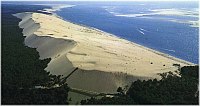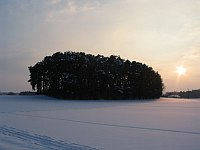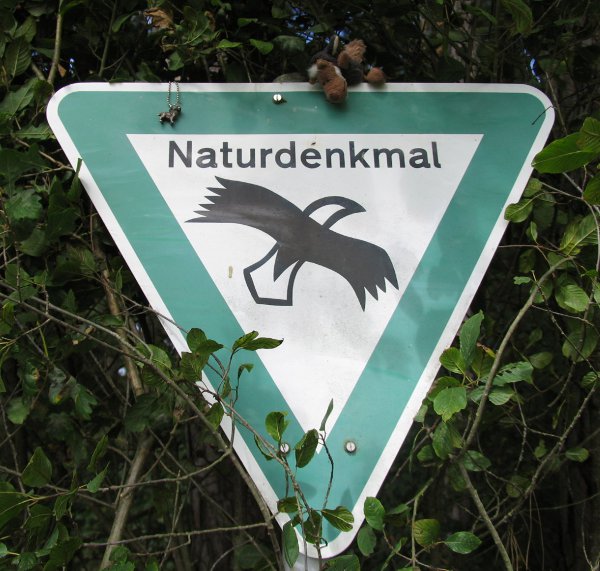Der Wüstenplanet
Soviel Sand und keine Förmchen ...
 Deutsche Version |
English version below
Deutsche Version |
English version below
 Wenn man
das Wort "Düne" hört, dann denkt man sofort an den Urlaub,
Atlantikstrand und viel Sonne. Das ist ja auch nicht falsch, aber
die Düne die Du heute besuchst ist etwas anders.
Wenn man
das Wort "Düne" hört, dann denkt man sofort an den Urlaub,
Atlantikstrand und viel Sonne. Das ist ja auch nicht falsch, aber
die Düne die Du heute besuchst ist etwas anders.
Wie entstehen Dünen? Egal ob es die "Dune
du Pyla" bei Arcachon in Südfrankreich oder die Düne bei Laag ist,
beide Sanddünen sind auf die gleiche Art und Weise entstanden.
Trockener Sand wird vom Wind aufgewirbelt und durch die Gegend
geblasen, irgendwo auf dem Weg von diesem Flugsand steht dann eine
kleine Pflanze oder ein anderes Hindernis. Im Windschatten von
diesem Hindernis lagert sich dann der erste Sand ab. Damit eine
Düne an einer Meeresküste wachsen ist, ein kompliziertes
Zusammenspiel von Wind, Sand und den Pflanzen nötig. Ohne Pflanzen
würde eine Düne nämlich einfach wandern - eine Wanderdüne eben. Die
Pflanzen, welche meist robuste Gräser sind, halten den Sand nicht
nur an der Oberfläche fest, sondern festigen die Düne auch mit
ihrem Wurzelwerk.
Durch den Wind bekommen Dünen übrigens auch ihr besondere Form: Auf
der dem Wind zugekehrten Seite (Luv) ist die Düne relativ flach,
während sie auf der dem Wind abgewandten Seite (Lee) sehr steil
abfällt. 
Und was ist jetzt so besonders an dieser
Düne? Das ist einfach: Sie ist alt, sehr alt. Normalerweise
sind Dünen aus dem Urlaub - also an der Atlantik bzw. Nordseeküste
- 500 bis 1000 Jahre alt. Das ist in geologischen Maßstäben sehr
wenig. Die Düne bei Laag dagegen stammt aus der Epoche
"Jung-Pleistozän", womit diese Düne über 10.000 Jahre alt ist!
Sind Dünen eigentlich nicht ziemlich
empfindlich? Ja, Dünen sind tatsächlich sehr abhängig vom
Bewuchs. Die Gräser, die auf den Küstendünen wachsen, sind sehr
schnell plattgetrampelt wenn zu viele Strandgänger über die Düne
latschen. Sobald der Bewuchs weg ist, fängt die Düne das wandern
an. In Küstenregionen ist das sehr gefährlich denn Dünen bieten
Schutz vor Fluten und anderen Gefahren welche vom Meer
ausgehen.
 Unsere Düne hier dagegen ist sehr gut geschützt: Die
mächtigen Kiefern halten die Düne sehr gut zusammen und ein starker
Küstenwind weht hier ja auch nicht oft ;-)
Unsere Düne hier dagegen ist sehr gut geschützt: Die
mächtigen Kiefern halten die Düne sehr gut zusammen und ein starker
Küstenwind weht hier ja auch nicht oft ;-)
Wie groß können Dünen werden? Die größte
Wanderdüne Europas, die Dune du Pyla, ist ca 137 m hoch. Diese
siehst Du auch auf dem Foto oben rechts. Aber in der Namib-Wüste in
Afrika gibt es Dünen die sogar bis zu 300 m hoch sind!
Gibt es noch mehr Dünen in der Gegend?
Natürlich! Du musst eigentlich in den umliegenden Wäldern nur die
Augen auf machen und dann wirst Dünenzüge erkennen. Einen besonders
deutlichen findest Du im Westen bei N 48° 34.110 E 011°
11.350. Obwohl diese Düne genauso alt ist wie die bei Laag,
kannst Du hier deutlich Luv (Süden) und Lee (Norden)
erkennen.
Wenn Du mehr über Dünen erfahren möchtest, dann schau
einmal bei Wikipedia.

Ihr bewegt Euch hier am
Rande eines sensiblen Gebietes - geschützt als
Naturdenkmal.
Bitte bleibt außerhalb
der Düne bzw. bewegt Euch höchstens auf dem Weg hinein, der beim
Schild an den Koordinaten beginnt.
Es ist für die Natur
vor Ort wünschenswert, dass Ihr keinen Hund
mitbringt!
Um diesen Earthcache eintragen zu dürfen,
benötige ich vorher die Antworten auf
diese Fragen:
1. In welchem
erdgeschichtlichen Zeitalter entstand die "Düne bei Laag"
(Internetrecherche) und von wann bis wann dauerte dieses? Lösung =
J...
2. In welcher Höhe (ü. NN)
ist die Düne gelegen?
3. Hinter dem Schild
stehen drei Bäume der gleichen Art, wie sie hier häufig vorkommt.
Welche sind dies und warum wachsen
diese hier so gut?
4. An der Südwestecke der
Düne steht ein mächtiger Baum, der nicht der Art aus Aufgabe drei
entspricht. Von welcher Art ist dieser Baumriese?
Mache bitte ein Foto von Dir mit GPSr am Schild
an den Koordinaten und stelle dieses mit ein.
Beispielfotos vom aktuellen Betreiber
hier und vom ursprünglichen Ersteller hier.
Planet of desert
So much sand and no sandbox moulds ...
 English version |
Deutsche Version oben
English version |
Deutsche Version oben
 If you
hear the word "dune" you think about holidays, the beach and sun.
That's not wrong at all but today we'll have a look at a slightly
different dune.
If you
hear the word "dune" you think about holidays, the beach and sun.
That's not wrong at all but today we'll have a look at a slightly
different dune.
In which way are dunes made? No matter if
you look at the "Dune du Pyla" at Arcachon in southern France or at
the dune here in Laag, both are made in the same way: The wind
raises dry sand and blows it through the land. Somewhere on the way
of the sand is a small plant or another obstacle. Within the
slipstream of this obstacle the first grains of sand deposit. Thus
the obstacle this means the dune itself starts to grow. In order
that a dune can grow at a shore a complicate interaction of wind,
sand and plants is necessary. The wind gives the dune its special
shape: It's quite smooth on the side towards the wind (Luv) and on
the other side (Lee) very steep. If there are no plants at all on a
dune, there's nothing which keeps the sand from moving. Then the
sand and with it the whole dune starts to move - a shifting sand
dune. Plants - most of the time robust grasses - keep the sand on
the surface and stabilise the dune with their roots. 
What does the dune in Laag make so
special? It's old, very old. Normal dunes at the coast of the
Atlantic or the North Sea are only abot 500 to 1000 years old. On a
geological scale that's not very much. However this dune originates
from the epoch Pleistocene which means it is over 10.000 years
old!
Aren't dunes quite fragile? Indeed, they
are. The grasses which grow on the dunes at the shore are easily
stamped down by people walking to the beach. As soon as the plants
are gone, the dune starts to move. At the shore this is very
dangerous since dunes protect the land behind them against floods
and other threads caused by the sea.
 However our dune has hughe trees on top of it and
strong winds like at the sea are also very seldom in the middle of
Bavaria ;-)
However our dune has hughe trees on top of it and
strong winds like at the sea are also very seldom in the middle of
Bavaria ;-)
How large can dunes be? The largest
shifting sand dune of Europe - the "Dune du Pyla" is about 137 m
high. You can see it in the top right picture. But there are also
dunes up to 300 m high in the Namib desert in Africa!
Are there more dunes around here? Sure!
Just keep your eyes open in the surrounding forests and you will
see some dune ranges. In the west at N 48° 34.110 E 011°
11.350 you'll find a very interesting one: Although it's as old
as the dune in Laag you actually can see Luv (south) and Lee
(north) of the dune.
If you want to learn more about dunes have a
look at wikipedia.

Here, you move on the
edge of a sensitive area - protected as natural
landmark.
Please stay off the
dune or move into it only on the path that starts at the sign at
the coordinates.
It is desirable for the
nature on site that you don't bring a dog with you!
Before you log this
Earthcache you need to answer me three questions:
1. In which geological
era was the dune at Laag ("Düne bei Laag") formed (Internet
research) and this era ranges from ... to ...?
2. In which altitude is
the dune located?
3. Behind the shield
are three trees of the same kind as they are often to find here.
What kind of trees is it and why do they grow here that
well?
4. At the south-west
corner is a mighty tree, not of the same kind as the trees in
Question three. Of what kind is this giant tree?
Please take a Picture of you with your GPSr
at the sign at the Coordinates and put it to your Log
Entry.
Example pictures of the owner
here and the former owner here.
